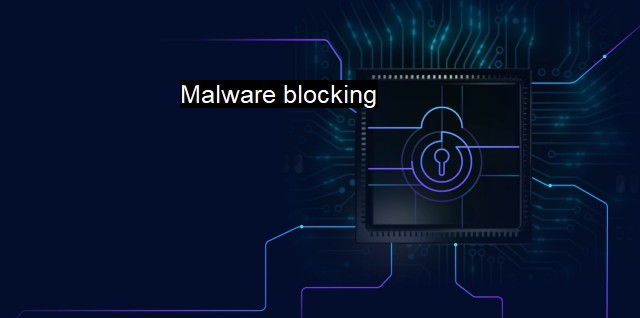What is Malware blocking?
Malware Blocking: Techniques and Strategies to Safeguard Your System Against Viruses, Trojans, Worms, Adware, and More
Malware blocking is an essential component in the frontline defense system of any cybersecurity strategy, offering a robust shield against potentially harmful and disruptive software infiltrating and compromising an individual or organization's files, databases, networks, and systems.Malware, a hazardous amalgamation of malicious and software, is generally harmful software stealthily installed on your device, often without your knowledge, aiming to disrupt, destroy, or gain access to your system and vital information. It is a broad umbrella term, encompassing various threats ranging from viruses, worms, and trojans to ransomware, spyware, and adware. Each strain of malware has distinctive attributes, behaviors, and damage potential, making them particularly challenging to identify and nullify.
This is where 'Malware Blocking' ascends as a lighthouse guide navigating safe digital terrains. It refers to an array of techniques, systems, and tools employed to identify, isolate and block malware in real-time or virtually real-time before they penetrate networks, access valuable data, or wreak havoc across the system.
Malware blocking technology integral to security software like antivirus or network security platforms is driven by sophisticated algorithms and intricate designs. These engines continuously stay alert, scanning files for threatening activities, behaviors, or signatures. It actively engages in traffic analysis and heuristics instead of solely relying on attack signatures. Forensic analysis helps in recognizing unknown malware, a potent weapon in a hacker's arsenal, leveling up protection and anticipation.
One main advantage of malware blocking is its capability to halt the malware at the entry point, not letting it spread or activate. Also, it largely quashes the need for 'system cleaning' or 'data recovery,' usually called for post a malicious attack. So, a preemptive interception straps the recipients from the stressful ordeal of pilfering through possible infection touchpoints to dismantle the havoc created. real-time blocking apps work quietly in the background, ensuring a seamless user experience.
Malware blocking is not without its challenges. Cyberthreats are evolving, becoming complex to a point where sly invaders often go undetected by rudimentary blocking techniques. As malware incorporates evasion tricks like metamorphism and polymorphism, the evasion of detection has arguably become easier. Another point of contention exists in 'Zero-day attacks.' With the attacker exploiting a previously unknown vulnerability before a patch or preventive barrier is ready, malware blocking faces conspicuous lags.
Despite the challenges, the significant role and effectiveness of malware blocking can't be understated. Even though it can't provide an absolute airtight protection cover against cybersecurity threats, it plays a profound role. It works by completing the security setting puzzle when adequately complemented with other solutions like penetration testing, intrusion detection systems, VPNs, and firewalls. A strong security spelled out by robust policies, malware blocking, and threat intelligence creates proactive responses to prevent successful offensive.
Typically embedded within an antivirus software package, malware blocking tools employ various strategies like scanning, quarantining, or supervised machine-learning in anticipating, detecting, and neutralizing threats. From blocking malicious URLs and scrutinizing all downloads to regularly scanning the file system and tracking anomalies, these tools have revolutionized malware blocking approaches.
Undoubtedly, in the unchartered yet burgeoning field of cybersecurity, malware blocking pops as an indispensable bulwark that doesn't merely react but anticipates and prevents. The ever-expanding scale of Internet connectivity brings attention to the critical importance of malware-blocking. True that it's not the end-all solution, but coupled with other techniques, it aids in creating a holistic and rigorous defense system. For individuals or businesses venturing into the digital sphere, prioritizing the integration of practical malware-blocking software into their systems strengthens the beacon to safe connectivity.

Malware blocking FAQs
What is malware blocking?
Malware blocking refers to the process of preventing malware from infecting a computer or network. It involves identifying and blocking known malware threats and preventing them from accessing vulnerable areas of a system.How does malware blocking work?
Malware blocking works by using advanced algorithms and heuristics to identify and block known and unknown malware threats. The process involves inspecting incoming traffic, analyzing it for any suspicious behavior, and blocking any potentially harmful content before it can reach the target system.Why is malware blocking important?
Malware blocking is important because malware can cause significant damage to a computer or network. Malware can steal sensitive data, compromise system performance, and even take control of a system to launch further attacks. Malware blocking helps protect against these threats, preventing costly and potentially devastating security breaches.How effective is malware blocking?
Malware blocking is highly effective when implemented correctly. However, no security solution is 100% foolproof, and new malware threats are being developed all the time. That's why it's important to keep security software up to date and to practice good cybersecurity hygiene, such as being cautious about opening email attachments or clicking links from unknown sources.| | A | | | B | | | C | | | D | | | E | | | F | | | G | | | H | | | I | | | J | | | K | | | L | | | M | |
| | N | | | O | | | P | | | Q | | | R | | | S | | | T | | | U | | | V | | | W | | | X | | | Y | | | Z | |
| | 1 | | | 2 | | | 3 | | | 4 | | | 7 | | | 8 | | |||||||